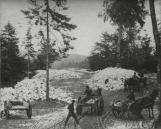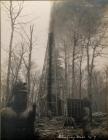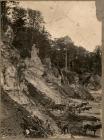14
Oil shale is another mineral found in large quantities in Albert County. Oil shale a mineral similar in appearance to coal can be burned like coal or distilled. When distilled the oil shale found in Albert County produces between 20 - 45 gallons of oil per ton, which is a greater amount than the oil shale produced in Scotland. Except for oil shale mines in Scotland, oil shale has never been mined profitably because it is cheaper to drill for oil and refine that oil rather than distill oil shale. However, perhaps in the future as oil prices continue to rise the oil shale reserves of Albert County may well be used to help supply the oil demands of the world.Besides mining oil shale the more traditional method of drilling for oil has also been done in Albert County. The Stoney Creek oil fields started producing crude oil and gas in 1909.
16
Oil had been found in nearby Westmorland county in 1859, however, another well had been discovered in Pennsylvania that same year. That well supplied all the oil needed in North America. No further exploration was done in Albert County or Westmorland County because there was no increase in the demand for oil until the development of the internal combustion engine in the early twentieth century. In 1923, the production of crude oil in Albert County was 308,984 gallons, and 619,673 thousand feet of gas. By 1925, sixty-six wells had been bored in the Stoney Creek oil fields.18
The method used to drill these wells was called the "cable tool" method. This involved using a thirty-five horsepower steam engine to raise a heavy tool three feet in the air and then letting it drop onto the ground, forty times a minute. After the heavy tool was finished pulverizing the ground the tool was lifted out of the hole and the pulverized rock was then mixed with water and pulled up out of the hole by a bailer attached to another cable. Next pipe casing was sunk into the drill shaft, the diameter of the pipe casing got progressively narrower as the hole went further into the ground.19
Two unidentified men drilling an oil well using the 'Cable Tool' method.19 September 1915
Stoney Creek, New Brunswick, Canada

20
Three unidentified men drilling into the ground using a steam powered drill.19 September 1915
Stoney Creek, New Brunswick, Canada
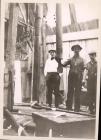
21
A group of men carrying pipe casings into the oil well.19 September 1915
Stoney Creek, New Brunswick, Canada
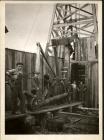
22
The oil was then pumped up from the ground through a two inch thick pipe that was lowered into the pipe casings. It could take anywhere from three months to an entire season to drill an oil well using this method. An oil and gas refinery was built at Weldon which supplied oil and gas to local area residents. The company that owned the refinery also owned two gas stations in the area and sold gasoline using the brand name MICMAC. Today, there is not much oil and gas exploration being carried out in Albert County, however, there are still a few oil wells in the area which are still producing gas. With the boom in natural gas exploration in Nova Scotia, and the recent discovery of large amounts of natural gas in the Sussex area, near Albert County, companies are beginning to consider reopening the oil and gas fields of Albert County.The most important of the minerals mined in Albert County was gypsum. By the 1930's Albert County produced eighty percent of the total output of gypsum in the Province. The gypsum mined in Albert County was considered to be some of the finest quality gypsum in the world. The Albert Manufacturing Company operated from 1854 until 1980.
23
A group of employees standing in front of the Albert Manufacturing Company Mill in Hillsborough.19 September 1912
Hillsborough, New Brunswick, Canada
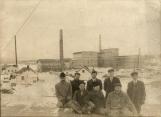
24
During this time the company operated a gypsum mine, four quarries, a private railway, and a plaster mill.27
Horses hauling two wheel dump carts full of gypsum from the quarry down to the train.19 September 1890
Hillsborough, New Brunswick, Canada
